Pelargonium sericifolium
Pelargonium sericifolium J.J.A van der Walt
Family: Geraniaceae
Common names: silky pelargonium (Eng.); naaldekoker (Afr.)
Introduction
This very rewarding stunner has all you will ever need. For starters it requires low maintenance and its silky leaves provide interest throughout the year. Its water needs are almost negligible. Then from mid-winter to mid-spring, its cerise flowers make this an unrivalled pot plant and groundcover for arid areas.
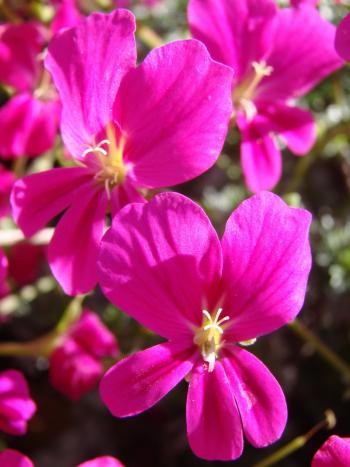
Description
Description
A small, much-branched, evergreen, shrub of 0.2 × 0.3 m. Simple, silvery green, wedge-shaped leaves, are shallowly lobed at the end and up to 10 mm long. The leaves are covered with dense silvery hairs or, in botanical terms, a sericeus indumentum. This covering gives the plant a silvery appearance.
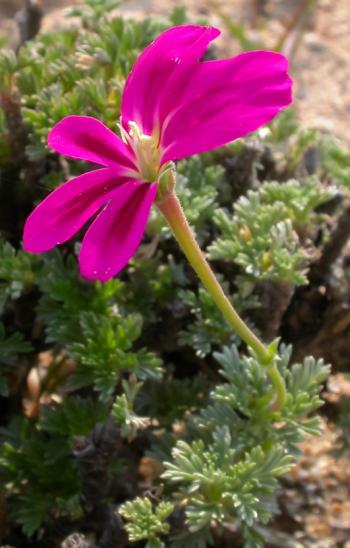
Cerise flowers of about 15 mm in diameter, in groups of 1–3, can be found from the end of winter (late July) to mid-spring (October). The pedicel of 1–3 mm long, and hypanthium of 35–60 mm long, are both sericeus. Silvery green, ovate to narrowly ovate sepals, are 7–9 mm long and 2–3 mm wide. Intense dark purple, linear markings, which merge near the base, can be found on the bottom 3 petals. Seven fertile stamens, all in variable sizes, are present. The pollen is yellow-lemon.
Conservation Status
Status
According to the Red List of South African plants, checked on 7 September 2017, the conservation status of this species is Least Concern (LC).

Distribution and habitat
Distribution description
The naaldekoker is restricted to the Spektakelberg outside Springbok and Kosies Mountain, near Sannagas, in the Namaqualand-region of the Northern Cape. In these broken and mountainous areas of Succulent Karoo, it grows on granite, gneiss and deep red sand.
Annual rainfall in this area is between 100–200 mm. The perennial presence of early morning mist is believed to supplement precipitation. The summers can be extremely hot, with occasional frost in winter.
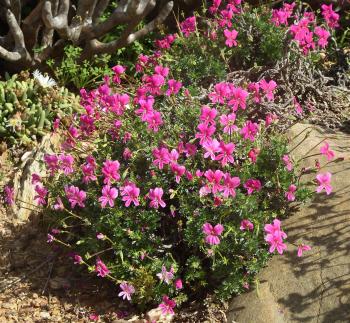
Derivation of name and historical aspects
History
The name Pelargonium is derived from the Greek word pelargos, meaning ‘stork’ because the rostrum of the schizocarp in Pelargonium is thought to resemble the bill of a stork. This explains the common name, stork’s bill. The specific epithet sericifolium, is derived from sericeus, which means ‘silky’ and is in reference to the conspicuous silky indumentum of the leaves.
Pelargonium is one of 5 southern African genera in the Geraniaceae, the pelargonium family. There are approximately 250 species of Pelargonium in southern Africa. The other southern African genera in Geraniaceae include: Erodium, Geranium, Monsonia and Sarcocaulon. This cosmopolitan family is predominantly confined to temperate and subtropical regions such as S, E and NE Africa, Australia, New Zealand, St Helena, Tristan da Cunha, Madagascar and Asia. Southern Africa, home to more than 80% of the species, is the global hotspot of Pelargonium. The highest diversity amongst members of this family is found in the Namaqualand-region, and the western and southern Cape of South Africa.
Pelargonium sericifolium was first collected by Drège at Kaus Mountain, in 1838. Harvey used the very same specimen when he described the new species in 1860, under the name P. sericeum. However, this specific name had by then already been in use since 1796 for the species that is today known as Pelargonium crassicaule. This resulted in the name being changed to sericifolium, which is of similar meaning.
Pelargonium sericifolium is among 23 species found in the section Ligularia within the genus Pelargonium. All these species possess relatively strong branches with subsucculent stems that are often woody at the base. Leaves are seldom entire, but rather pinnately divided. The petals are subequal and spathulate with a tapering base. Seven fertile stamens can be found. Several other species found in this section include: P. abrotanifolium, P. crassipes, P. pulchellum, P. hirtum and P. fragile.
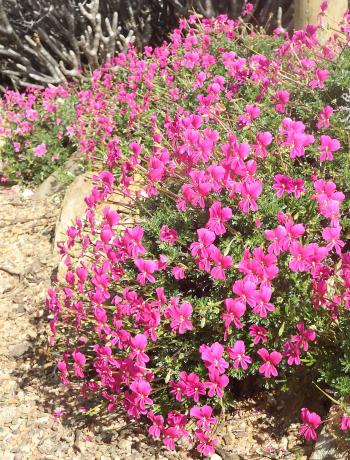
Ecology
Ecology
The specific pollinator of the flowers of Pelargonium sericifolium is not known. Bumble bees, carpenter bees, honey bees and butterflies are just some of the insects that are involved with the pollination of Pelargonium.
The light seeds of Pelargonium have a feathered, tail-like structure, which is coiled in a spiral arrangement. The tail enables the seed to twist around in the wind and drills itself into the soil. This action ensures more seed have a better chance of germination.
Uses
Use
Le Roux & Schelpe (1997) state that this is a rather palatable plant. No mention is being made as to whether this is applicable to humans or animals.
Although somewhat unknown in the horticultural industry, perhaps with the exception of collectors, the primary function of this species is undoubtedly ornamental, where it is a delightful groundcover planted en masse or interplanted with other succulents or arid species. In addition, it makes for superb pot plants and is ideal for a rockery.
Pelargoniums are generally popular garden ornamentals and some species are extensively cultivated for their medicinal properties. Essential oils found in the leaves of some species, is often used in the food, perfume and pharmaceutical industries.
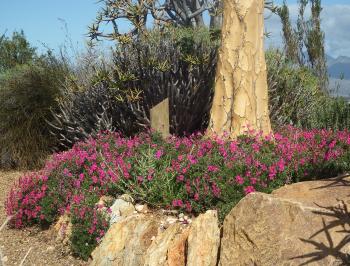
Growing Pelargonium sericifolium
Grow
This very rewarding groundcover grows easily from cuttings and seed.
Cuttings can be taken throughout the year, with best results achieved in autumn. Take stem cuttings larger than 30 mm, cut below the node and dip in a rooting hormone. The cuttings can then be placed in prepared holes in a rooting medium, such as coarse river sand. Prior to this, provision needs to be made to ensure the medium is sterilized. Cuttings can then be placed in a slightly shady place or a cold frame. Roots should appear after 3–4 weeks. Undertake potting only once a proper root system has developed.
Sow seed in late summer or early autumn, in a well-draining medium and cover with a very thin layer of white river sand or compost. Water seed evenly with a very fine spray. Take care not to overwater, but also not to allow the medium to dry out completely.
Rooted cuttings and seedlings respond well to a liquid seaweed-based fertilizer. Feed adult pot plants with 3:1:5 once in autumn. This can be supplemented with a seaweed-based, liquid fertilizer application every fortnight during the growing season.
An extensive, deep root system, makes the transplanting of the naaldekoker from a garden, a challenge. Plants do pot on very easily though.
This species makes a stunning pot plant and has minimal pest and disease issues. Limit watering over the summer to once or twice over a fortnight, to prevent rotting. Increase watering with the onset of autumn.
Companion plants may include: Pelargonium crithmifolium, P. echinatum, P. incrassatum, P. magenteum and P. crassicaule, Sarcacaulon crassicaule, Aloidendron dichotomum, Aloe arenicola and A. komaggasensis, Dimorphotheca sinuata and D. pluvialis, Senecio arenarius, Arctotis hirsuta and A. fastuosa, Oncosiphon suffruticosum and O. grandiflorum, Veltheimia capensis, Lessertia frutescens, Lampranthus hoerleianus, Leysera gnaphaloides and Euphorbia mauritanica.
No serious pests and diseases have been observed.
References
- Joffe, P. 2003. Easy guide to indigenous shrubs. Briza Publications, Pretoria.
- Koekemoer, M., Steyn, H.M. & Bester, S.P. 2015. Guide to Plant Families of southern Africa. Strelitzia 31. 2nd ed., 2nd print. South African National Biodiversity Institute, Pretoria, South Africa.
- Le Roux, A. & Schelpe, T. 1997. Namaqualand. South African Flowering Guide 1. Botanical Society of South Africa, Cape Town.
- Oliver, R. 2017-09. Pelargonium hirtum (Burm.f.) Jacq. (Geraniaceae). PlantZAfrica. Internet 7 pp. http://pza.sanbi.org/pelargonium-hirtum
- Van der Walt, J J A. 1977. Pelargoniums of South Africa. Purnell, Cape Town.
- Van der Walt, J.J. & Vorster, P.J. 1981. Pelargoniums of southern Africa, vol. 2. Juta, Cape Town, Johannesburg.
Credits
Roger Oliver
Kirstenbosch National Botanical Garden
October 2017
Plant Attributes:
Plant Type: Ground Cover, Shrub
SA Distribution: Northern Cape
Soil type: Sandy, Clay
Flowering season: Spring, Winter
PH: Neutral
Flower colour: Purple, Pink, Mauve/Lilac
Aspect: Full Sun
Gardening skill: Easy
Special Features:
Horticultural zones









Rate this article
Article well written and informative
Rate this plant
Is this an interesting plant?
Login to add your Comment
Back to topNot registered yet? Click here to register.